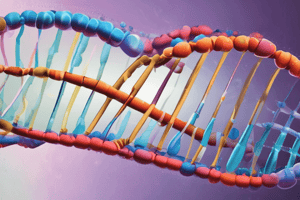Podcast
Questions and Answers
What is the composition of each daughter DNA molecule?
What is the composition of each daughter DNA molecule?
- Two old strands
- One old strand and two new strands
- One old strand and one new strand (correct)
- Two new strands
What is the base pairing rule in DNA replication?
What is the base pairing rule in DNA replication?
- Adenine pairs with Guanine
- Guanine pairs with Thymine
- Adenine pairs only with Thymine (correct)
- Cytosine pairs with Adenine
What is the direction of the complementary strand in DNA replication?
What is the direction of the complementary strand in DNA replication?
- Parallel to the template strand
- Opposite direction of the template strand (correct)
- Same direction as the template strand
- Perpendicular to the template strand
What is the function of DNA polymerase in DNA replication?
What is the function of DNA polymerase in DNA replication?
What is the role of DNA ligase in DNA replication?
What is the role of DNA ligase in DNA replication?
What is the direction of DNA synthesis?
What is the direction of DNA synthesis?
What is the function of topoisomerase in DNA replication?
What is the function of topoisomerase in DNA replication?
What is the requirement for DNA synthesis?
What is the requirement for DNA synthesis?
What is the direction of DNA synthesis in the leading strand?
What is the direction of DNA synthesis in the leading strand?
What is the function of the primase enzyme?
What is the function of the primase enzyme?
What is the role of DNA polymerase ε in replication?
What is the role of DNA polymerase ε in replication?
What is the function of ligase enzyme in replication?
What is the function of ligase enzyme in replication?
What is the direction of DNA synthesis in the lagging strand?
What is the direction of DNA synthesis in the lagging strand?
What are Okazaki fragments?
What are Okazaki fragments?
What is the direction of the replication fork movement?
What is the direction of the replication fork movement?
What is the direction of DNA polymerase δ synthesis in the lagging strand?
What is the direction of DNA polymerase δ synthesis in the lagging strand?
What is the primary function of helicase enzymes in DNA replication?
What is the primary function of helicase enzymes in DNA replication?
What is the purpose of topoisomerase enzymes in DNA replication?
What is the purpose of topoisomerase enzymes in DNA replication?
What is the characteristic of the short sequence at the origin of replication?
What is the characteristic of the short sequence at the origin of replication?
What is the role of single-stranded binding proteins in DNA replication?
What is the role of single-stranded binding proteins in DNA replication?
What is the shape of the structure formed during DNA replication?
What is the shape of the structure formed during DNA replication?
What is the problem that occurs in the region of DNA ahead of the replication fork?
What is the problem that occurs in the region of DNA ahead of the replication fork?
What is the function of the primer in DNA replication?
What is the function of the primer in DNA replication?
What is the direction of DNA synthesis in semi-conservative replication?
What is the direction of DNA synthesis in semi-conservative replication?
Flashcards are hidden until you start studying
Study Notes
Structure of DNA
- Each daughter DNA molecule consists of one old strand (parental strand) and one new strand (from free nucleotides in the nucleus)
- The base pairing rule is maintained: Adenine pairs with Thymine (A-T, two H bonds) and Cytosine pairs with Guanine (C-G, three H bonds)
- A + G = T + C in DNA molecule
Replication Process
- Replication is a bidirectional process that proceeds in both directions
- Synthesis of new strand occurs in 5' to 3' direction by DNA polymerase
- The process requires a template, primer, and substrates (dATP, dGTP, dCTP, and dTTP)
Enzymes and Proteins Involved
- DNA helicases: unwind double-stranded DNA
- Single-stranded DNA binding protein (ssDB): stabilizes single-stranded DNA
- Primase: synthesizes RNA primer
- DNA polymerase: chief enzyme for DNA chain elongation, repair, and proofreading
- DNA ligase: joins Okazaki fragments
- Topoisomerase: relieves torsional strain by cutting and joining single strands or both strands
Steps of DNA Replication
- Identification of the origin of replication
- Unwinding of double-stranded DNA by DNA helicase
- Binding of single-stranded DNA by ssDB
- Synthesis of RNA primer by primase
- Synthesis of new DNA strand by DNA polymerase
- Proofreading and repair by DNA polymerase
- Ligation of newly synthesized DNA segments by DNA ligase
Leading Strand and Lagging Strand
- Leading strand: synthesized continuously in 5' to 3' direction by DNA polymerase ε
- Lagging strand: synthesized discontinuously in short fragments (Okazaki fragments) by DNA polymerase δ
Primers Removal and Ligation
- Excision of RNA primers by exonucleases
- Removal of RNA primers and ligation of newly synthesized DNA segments by DNA ligase
Studying That Suits You
Use AI to generate personalized quizzes and flashcards to suit your learning preferences.




